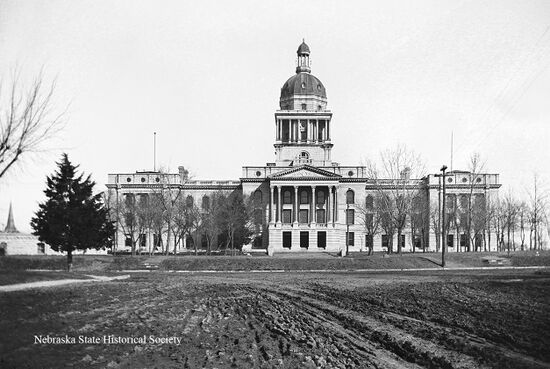William H. Willcox (1832-1929), Architect
William H. Willcox was born on May 26, 1832 in Brooklyn, New York City. He was an architect and surveyor with a background in topographical engineering gained during the Civil War, drawing maps for the Union Army. According to the Wikipedia article on him, he began practice in the 1850s in New York State, and practiced continuously until around the 1910s. Wilcox was a peripatetic architect who worked his way across the country, from New York to Chicago, St. Paul, Seattle, Los Angeles, and San Francisco. When he designed the second capitol for Nebraska, he was working out of Chicago.[3][a] He died at a Veterans Home in Yountville, California on February 1, 1929. [5]
This page is a contribution to the publication, Place Makers of Nebraska: The Architects. See the format and contents page for more information on the compilation and page organization.
Contents
Educational & Professional Associations
1881: architect, Chicago, Illinois. [6]
1882: architect, Chicago, Illinois & Washington Territory. [6]
Buildings & Projects
Second Nebraska State Capitol (1879-1884), 15th & J, Lincoln, Nebraska.[1][2][11][b]
Congregational Church (1880-1882), Winona, Minnesota.[8][9][c]
St. Paul's Methodist Episcopal Church (1883-1885), Lincoln, Nebraska.[4][9][10]
First Presbyterian Church (n.d.), Clinton, Iowa. [4]
Undated
Episcopal Church (n.d.), Emmetsburg, Iowa. [4]
State Journal Building (n.d.), Lincoln, Nebraska. [4]
State Reform School (n.d.), Kearney, Nebraska. [4]
Notes
a. The Wikipedia article [3] has him practicing in Nebraska, 1879-1882, but he does not appear in either the business or individual sections of Lincoln city directories from 1878-1882.
b. The cornerstone of the Second Capitol was retained upon demolition of the building, and installed at the northeast corner of the current State Capitol, alongside the new cornerstone. The old stone identifies William H. Willcox as "Architect & Superintendent" and provides a date of 1884--the commencement of the central portion of the building. The Chicago Daily Tribune noted with a dateline "Lincoln, Neb., Aug. 27 [1879] "that the plans submitted by Mr. Wilcox, of Chicago, for the new State-House have been adopted..." The Tribune describes that "The Wilcox plan provides for a building the extreme length of which is 290 feet; extreme breadth, 130 feet; the hight [sic] of cornice from water-table, 66 feet; hight [sic] of roof, 86 feet; of dome, 200 feet." Some modern sources misidentify the architect as B. H. Wilcox.[1][2][11]
c. The Saint Paul Globe advertisement of 1886 for the partnership of Willcox and Johnston lists twenty of "our recent buildings." The list clearly includes Willcox projects preceding the partnership, such as "State House, Lincoln, Neb." and "M. E. Church, Lincoln, Neb." "Congregational Church, Winona" is another example thereof.[9]
References
1. Oliver, Richard. Bertram Grosvenor Goodhue (American Monograph Series, ed. Robert A. M. Stern). New York: The Architectural History Foundation, and Cambridge & London: The M.I.T. Press, 1983, p. 184.
2. Pollak, Oliver B., Nebraska Courthouses: Contention, Compromise, and Community. (Images of America Series) Chicago: Arcadia Publishing, 2002, p. 11. [725.1.P771n]
3. Anon. “William H. Wilcox,” Wikipedia: The Free Encyclopedia. February 17, 2010. http://en.wikipedia.org/wiki/William_H._Willcox Accessed June 5, 2012.
4. William H. Wilcox, Hints to Those Who Propose to Build, (St. Paul, Minnesota: The Pioneer Press Publishing Company, 1884).
5. “Willcox, William H.” Shaping Seattle Architecture: A Historical Guide to the Architects (Seattle: University of Washington Press, 1994), 354.
6. Minnesota Missionary vol. 1 (August 1881).
7. Minnesota Missionary vol. 5 (June 1882).
8. Alan K. Lathrop, Churches of Minnesota: an Illustrated Guide, (University of Minnesota Press, 2003), 228-229.
9. "Willcox & Johnston, Architects," advertisement in Saint Paul Globe (January 10, 1886), 2.
10. A. B. Hayes & Sam D. Cox, History of the City of Lincoln, (Lincoln: State Journal Company, 1889), 248-249, 251.
11. "Nebraska Notes. Description of the New State-House Soon to Be Put Up," Chicago Daily Tribune, (August 29, 1879), 3.
Other Sources
John Bullock, The American Cottage Builder: A Series of Designs, Plans, and Specifications. (New York: Stringer & Townshend, 1854), 239f.[3]
Ira L. Bare and Will H. McDonald. Illustrated History of Lincoln County, Nebraska and Her People. (Chicago and New York: American Historical Society, 1920), 375-376.
A. E. Sheldon, Semi-Centennial History of Nebraska: Historical Sketch (Lincoln: Lemon Publishing, 1904).
Page Citation
D. Murphy, “William H. Willcox (1832-1929), Architect,” in David Murphy, Edward F. Zimmer, and Lynn Meyer, comps. Place Makers of Nebraska: The Architects. Lincoln: Nebraska State Historical Society, December 6, 2016. http://www.e-nebraskahistory.org/index.php?title=Place_Makers_of_Nebraska:_The_Architects Accessed, December 5, 2025.
Contact the Nebraska State Historic Preservation Office with questions or comments concerning this page, including any problems you may have with broken links (see, however, the Disclaimers link at the bottom of this page). Please provide the URL to this page with your inquiry.
